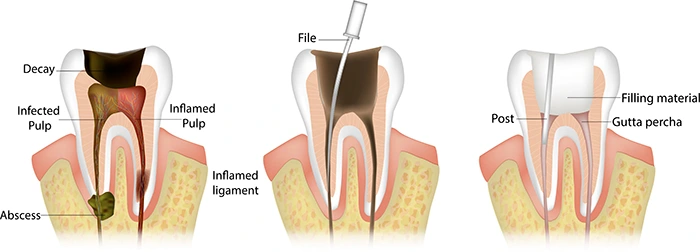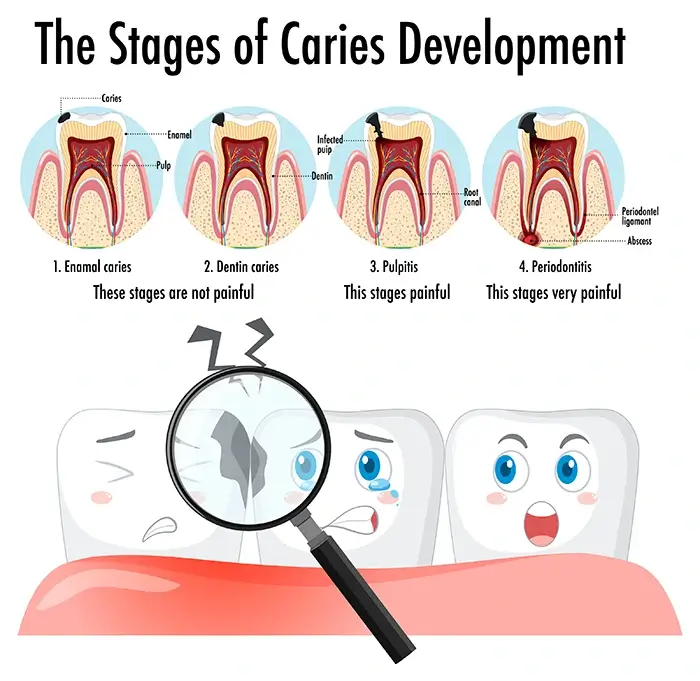Root CanalWhen properly cared for, your teeth should last your whole life. Unfortunately, this is often not the case. Things can happen that can cause teeth to become damaged, which can lead to infection and the need for restorative dental treatments. If you have a damaged tooth, the team at Avery Dental Center will strive to save the structure of the tooth when possible. This is often done with root canal therapy. In this article, we’ll explain more about root canal therapy, how you know you need it, and how it works. What is a Root Canal? The root canal is the innermost portion of the tooth where the pulp is. The tooth pulp is where the nerves and blood vessels are located that keep the tooth nourished. When the pulp becomes infected, root canal therapy is necessary. Root canal therapy is the process of removing the infected tooth pulp, disinfecting the root canal, and replacing it with a biocompatible material that supports the structure of the tooth from the inside. This treatment allows us to salvage the structure of the natural tooth instead of having to extract it. The root canal is the innermost portion of the tooth where the pulp is. The tooth pulp is where the nerves and blood vessels are located that keep the tooth nourished. When the pulp becomes infected, root canal therapy is necessary. Root canal therapy is the process of removing the infected tooth pulp, disinfecting the root canal, and replacing it with a biocompatible material that supports the structure of the tooth from the inside. This treatment allows us to salvage the structure of the natural tooth instead of having to extract it. How Do I Know I Need Root Canal Treatment?There are several signs that you may need root canal treatment, including: Persisting Chronic ToothachesTooth pain may be an indication that your tooth pulp is infected. You may have pain from time to time or it may bother you all the time. The pain may be in the tooth and the jawbone where the tooth is located or may be referred to other areas of your mouth. Tooth pain may not always be due to infected pulp- there are other causes for toothache. However, early diagnosis and treatment are critical to ensure the best outcome. AbscessesAn abscess is a pimple- or boil-like spot on the gum near the affected tooth. This is a tell-tale sign that you have an infection that must be treated promptly. If left untreated, the infection may spread to other areas of your body such as your heart or brain. If it spreads to these areas, it could be life-threatening. Swelling Around TeethAcidic waste products from the dead pulp can cause the gums around the affected tooth to swell. Swelling may be persistent or may come and go. Some patients have no pain at all with the swelling, while others experience pain when the gum is touched. Severe SensitivityIf your tooth is sensitive to hot/cold foods and beverages or sensitive to touch, it is an indication that the nerves and blood vessels are infected or damaged. The sensitivity may be dull or sharp and often comes and goes. You may only experience pain when touching the area around the affected tooth or when eating/drinking or it may linger even after the touch stimulus is over. Cracked ToothA cracked tooth opens up the inside area of the tooth for bacteria to get in. If caught early, a crack can be repaired, and root canal treatment may not be necessary. However, if left untreated, bacteria can get into the tooth pulp and cause the above issues, which indicates that root canal treatment may be your best option. Step-by-Step Guide to Root Canal Treatment There are five steps involved in root canal treatment, which usually take place over one or two dental visits. There are five steps involved in root canal treatment, which usually take place over one or two dental visits.Step 1: PrepThe first step is to prepare the treatment area. This involves administering local anesthesia and placing a dental dam to protect the rest of your mouth as well as the affected tooth. Step 2: Opening the toothNext, the dentist will drill a small hole in the tooth to allow the pulp to be removed. If you have any abscesses, those will be removed at this time. Step 3: Cleaning the toothOnce all of the pulp has been removed, the dentist will thoroughly clean and disinfect the tooth. Step 4: Shaping the rootsThe dentist will take the time to shape each tooth root to ensure that all of the dead pulp has been removed and the fill material can get into them. Step 5: Filling the toothThe final step in the process is to fill the tooth with a biocompatible material that will support the structure of the tooth from the inside. At this time, the dentist will seal the tooth with a dental filling. If you need a dental crown, impressions will be taken, and the crown will be ordered. You will need to return for another appointment to have the crown placed. How do you know you need an emergency root canal?If you have an extreme toothache, an abscess, a fractured tooth, or damage from trauma, you may need emergency root canal therapy. What are the benefits of root canal treatment?Root canal treatment offers many benefits, including:
How long does a root canal take?A simple root canal treatment takes approximately 30 minutes to an hour. However, you should expect to spend an average of 90 minutes in the office. Molars take longer because they can have up to four roots. On average, molars take about 90 minutes from start to finish. Premolars usually have one or two roots and can take up to an hour or so, depending on the tooth. Canines and incisors are the easiest because they typically have only one root and can be completed within about 45 minutes. How much is a root canal?Root canal therapy ranges from around $700 to $2,100 for the procedure itself, depending on the location of the tooth. A front tooth costs less than a molar because it is easier to access. Since this is a restorative dental procedure, most dental insurance providers will cover a portion of the treatment. Do root canals hurt?Root canal therapy should not hurt. We start by administering local anesthesia to numb the area around the affected tooth. We also offer sedation for patients who have dental anxiety. Once the anesthesia wears off, you may have some minor discomfort, primarily due to having your mouth open for so long. However, this should resolve within a few days. If you do have extreme pain, contact the dental clinic so that we can determine the problem. Root canal experts in Dublin, OHIf you have a persisting toothache, an abscess, swelling around your teeth, extreme sensitivity, or a cracked tooth, schedule your consultation with the root canal experts in Dublin. The team at Avery Dental Center will perform a comprehensive exam to determine which tooth is causing the problems and determine the best course of treatment. When possible, we will do root canal therapy to save the structure of the tooth. If this is not possible, extraction may be required. At this time, we can explain our options for tooth replacement. Root Canal Therapy FAQsRoot canal therapy is a fairly invasive procedure, but it does come with many benefits including salvaging the structure of the tooth. If you have any questions or concerns about root canal treatment, we will be happy to address them for you. Below are some of the most common questions that we get about this procedure: Can you eat after a root canal?You should avoid eating until after the anesthesia has worn off. When you do eat, stick with soft foods and avoid chewing on the treated tooth for at least a few days. Can you smoke after a root canal?Smoking in general has a negative impact on your overall health. Therefore, it’s a good idea to quit. If you need tips on quitting, our team will be happy to help. Can you drive after a root canal?Typically, patients are only given local anesthesia, which means that you should be okay to drive following your procedure. However, if you have dental anxiety and require sedation, you’ll want to bring someone that can drive you home and sit with you until the anesthesia wears off. Do they put you to sleep for a root canal?Typically, patients are not fully sedated- only local anesthesia is required for the procedure but if you do have dental anxiety, sedation options are available. Can I brush after root canal?Yes, you can brush and floss your teeth following root canal treatment. However, it’s best to wait until the anesthesia has worn off. Also, be careful flossing around the treated tooth once the crown is placed- you could accidentally loosen the crown and cause it to fall off. How long does a root canal last without a crown?A tooth treated with root canal therapy can last a lifetime if cared for properly- even without a crown. However, a crown is better than a filling because it protects the entire structure of the tooth. |